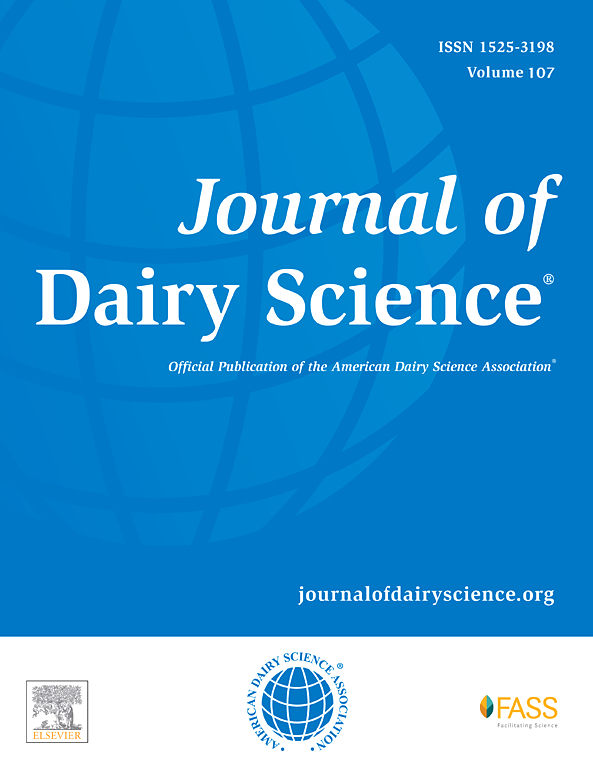Metabolomics study on fermentation of Lactiplantibacillus plantarum ST-III with food-grade proliferators in milk
IF 4.4
1区 农林科学
Q1 AGRICULTURE, DAIRY & ANIMAL SCIENCE
引用次数: 0
Abstract
Milk is a naturally complex medium that is suitable for the growth of most lactic acid bacteria. Unfortunately, Lactiplantibacillus plantarum ST-III, a probiotic strain of bacteria used to produce fermented foods, grows poorly in milk without supplementation. To solve this problem, we used fresh pineapple and mung bean juice to develop an edible proliferator for L. plantarum ST-III. Our comparative analysis of changes in metabolomics before and after fermentation revealed that amino acids, dipeptides, nucleotides, and vitamins were the most consumed compounds, implying the mechanism of proliferation. These results, in combination with Kyoto Encyclopedia of Genes and Genomes metabolic pathway analysis, were used to screen substances that could promote the growth of L. plantarum ST-III in milk. To explore which component of the proliferator was required for L. plantarum ST-III growth, we supplemented milk with several combinations of substances from the proliferator that were identified as promoting growth. The experimental results showed that if any of these substances were missing, the concentration of viable bacteria was lower. The highest concentration of viable bacteria could only be obtained when all the substances were added to the milk. Compared with the control, the concentration of viable bacteria was about 32-fold higher in milk that contained the proliferator. Thus, the study proves that milk primarily lacks available amino acids, dipeptides, uracil, xanthine, nicotinamide, and manganese, which are necessary for the growth of L. plantarum ST-III.
植物乳杆菌 ST-III 与食品级增殖物在牛奶中发酵的代谢组学研究。
牛奶是一种天然复合培养基,适合大多数乳酸菌生长。遗憾的是,植物乳杆菌 ST-III 在牛奶中生长不良,没有补充剂。为了解决这个问题,我们利用新鲜菠萝和绿豆汁开发了一种可食用的植物乳杆菌 ST-III 增殖剂。我们对发酵前后代谢组学变化的比较分析表明,氨基酸和二肽是消耗最多的化合物,其他物质包括核苷酸和维生素,这意味着增殖的机制。结合 KEGG 代谢途径分析,筛选出了可能促进牛奶中植物乳杆菌 ST-III 生长的物质。为了探索植物乳杆菌 ST-III 的培养需要增殖因子中的哪种成分,我们在牛奶中添加了上述几种分子组合。牛奶中植物乳杆菌 ST-III 的模拟添加实验结果表明,如果缺少任何一种添加剂,活菌的浓度就会降低。只有在含有所有添加剂的情况下,才能获得最高的活菌浓度。与对照组相比,有活力细菌的折叠变化约为 32。因此,这证明牛奶主要缺乏植物乳杆菌 ST-III 生长所需的氨基酸、二肽、尿嘧啶、黄嘌呤、烟酰胺和锰。
本文章由计算机程序翻译,如有差异,请以英文原文为准。
求助全文
约1分钟内获得全文
求助全文
来源期刊

Journal of Dairy Science
农林科学-奶制品与动物科学
CiteScore
7.90
自引率
17.10%
发文量
784
审稿时长
4.2 months
期刊介绍:
The official journal of the American Dairy Science Association®, Journal of Dairy Science® (JDS) is the leading peer-reviewed general dairy research journal in the world. JDS readers represent education, industry, and government agencies in more than 70 countries with interests in biochemistry, breeding, economics, engineering, environment, food science, genetics, microbiology, nutrition, pathology, physiology, processing, public health, quality assurance, and sanitation.
 求助内容:
求助内容: 应助结果提醒方式:
应助结果提醒方式:


